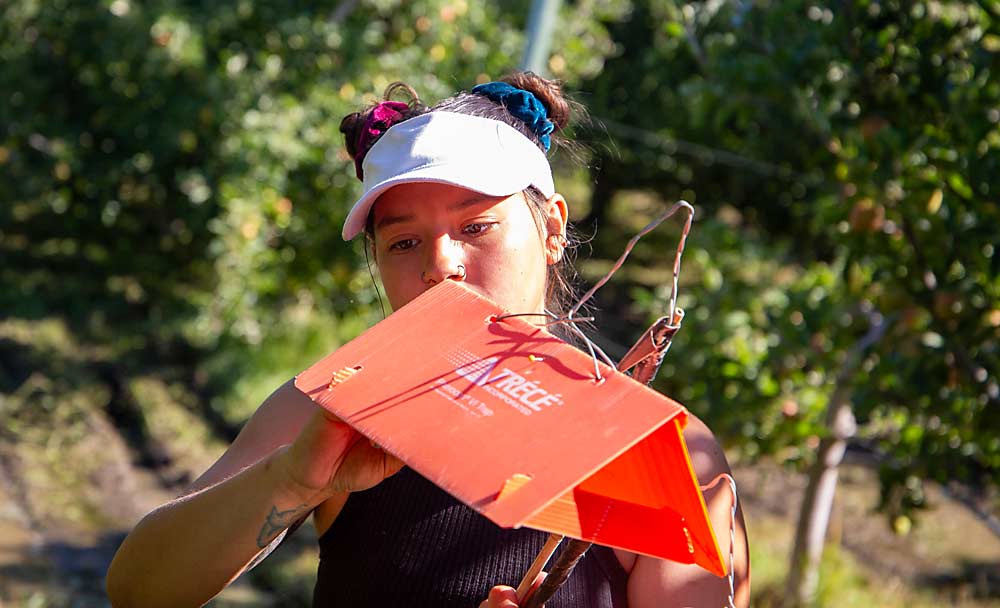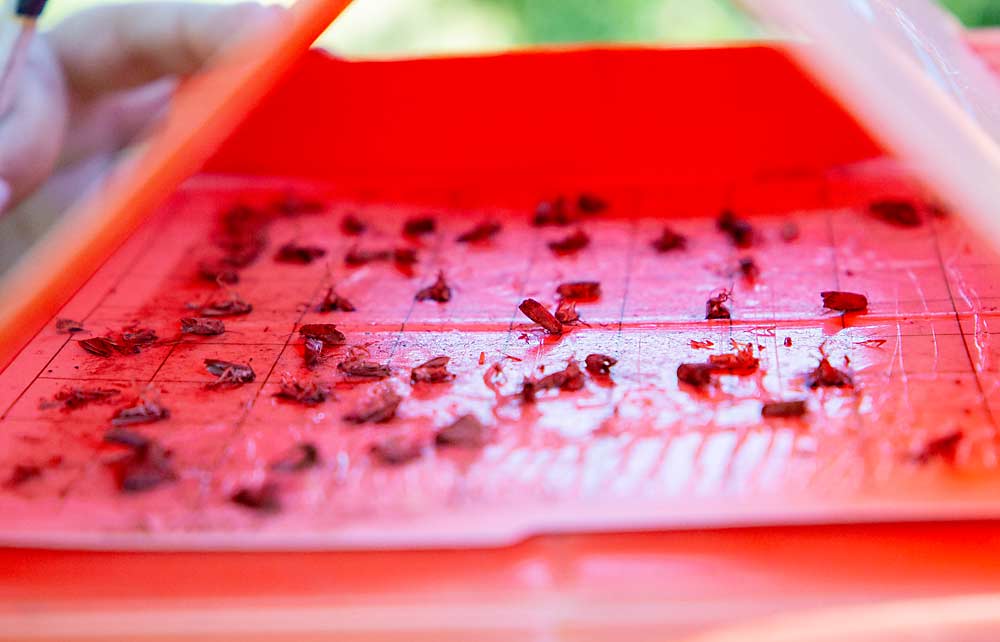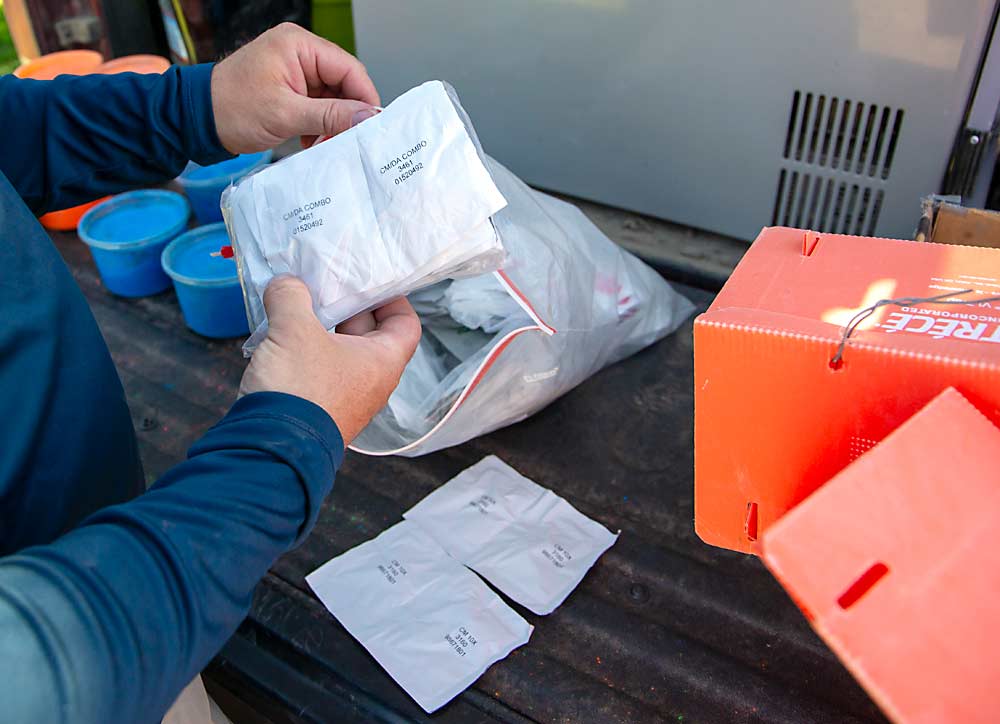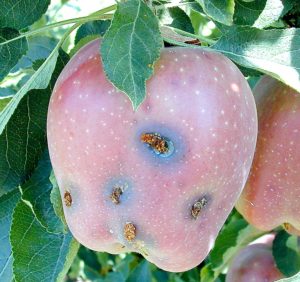—story and photos by Ross Courtney
—graphic by Jared Johnson

Three years ago, Washington State University entomologist Rob Curtiss launched a vast and expensive effort to determine how Northwest codling moths move around in the age of mating disruption.
“The challenge of understanding your monitoring program is understanding what capture means when you’re using all these different lures, or maybe even different trap types,” Curtiss told growers in December at the Codling Moth Study Circle in Yakima. “What we really want to know is … if you catch a single moth, what does that mean?”
The answer depends on the type of lure and the type of mating disruption. Curtiss and lab manager Toriani Kent summarized their results into a table, telling growers how many traps per acre they need, what the trap catch translates to in terms of moth population, and how well their mating disruption programs are working across variables, said Teah Smith, an entomologist and consultant for Zirkle Fruit Co.

“I think it’s very robust data that gives us practical guidelines to follow,” said Smith, also a member of the Washington Tree Fruit Research Commission, which funded Curtiss’ project.
A lot of his results confirm what growers and pest consultants had inferred from years of observations, but lacked science to back up, said Byron Phillips, key account manager at Wilbur-Ellis.
“It’s going to make us sure feel a lot more comfortable,” Phillips said.
Codling moth has long been an arch nemesis of apple and pear growers, and organic growers in particular report an increase in pressure in recent years. Most models and action threshold guides have been built on research from Michigan and did not factor in mating disruption or newer lures that attract females and males.

Curtiss’ project is one of several stemming from a renewed research interest in codling moth — and one of the most expensive, at nearly $600,000.
Most of that money was the cost of importing sterilized moths from a rearing facility in Osoyoos, British Columbia, to track in study orchards. The project also was large in scope, with 45 commercial trial sites, each 10 acres, over three years throughout Central Washington, for a total of 297 replications.
Research commissioners flinched at the price tag but decided the project was worth the cost, said Smith, chair of the commission’s apple crop protection committee.
“They were questions we really wanted answered,” Smith said.
Conclusions
Curtiss’ table breaks down moth population dispersal distance, population density, trap area and a recommended number of traps per acre across 15 variables — five different lures and three different mating disruption scenarios.
For example, in a trap baited with CMDA+AA lure — a Trécé product using a combination of pheromone, pear ester and acetic acid — in an orchard with passive mating disruption, one moth captured represents a population of 241 moths per acre in a trap area of 5.7 acres. The statistics work out to recommend 1.74 traps per 10 acres. (Curtiss suggests farmers round up to two traps per 10 acres, but as acreage grows, the need to round up is reduced, so 18 traps for 100 acres and 174 traps for 1,000 acres.)

Those numbers shift under active disruption, or aerosol emitters, or no mating disruption, which Curtiss tracked as a control. Passive disruption refers to the manually applied dispensers, such as twist ties or hanging puzzle pieces. The type of lure — pheromones, plant compounds or a mixture — also plays a role.
All the trap density estimates fell between 1.5 and two traps per 10 acres, roughly in line with modern conventional advice. He hopes his table arms crop consultants with evidence they can use to debate with growers who want to scale back trapping to save money.
Another conclusion was how far moths fly: between 266 feet and 312 feet — only about the length of a football field. That tells growers that if they have moths, they had better think twice before blaming their neighbors, Smith said.
“It’s more likely that your problem is coming from somewhere right next to your orchard or in your orchard, and it’s your problem,” she said.
Also, passive mating disruption programs appear to be more … well, disruptive than active. Across all the lure types, fewer moths made it to the traps in passive programs. That means they were more distracted by the pheromone dispensers, Curtiss said.
Curtiss and Kent performed the study by releasing sterilized moths from increasing distances in concentric rings around central trap sites. The moths, dyed different colors corresponding to the release distance, were counted on the sticky catch trays.
The project also involves an economic analysis of the costs and benefits for each combination of lure and mating disruption.
He’s still getting there. Curtiss and Kent only finished processing the trap catches in December and wrapped up analysis in time for the research commission’s Apple Crop Protection Research Review in late January.
“The economic work is still pending,” Curtiss said. •








Leave A Comment